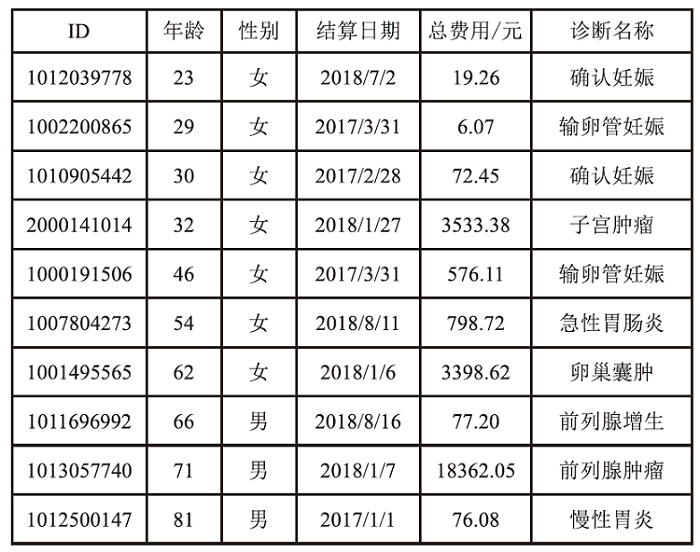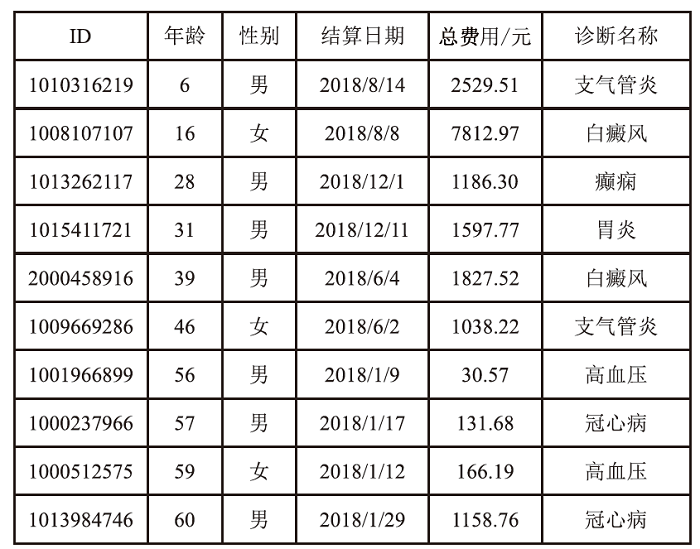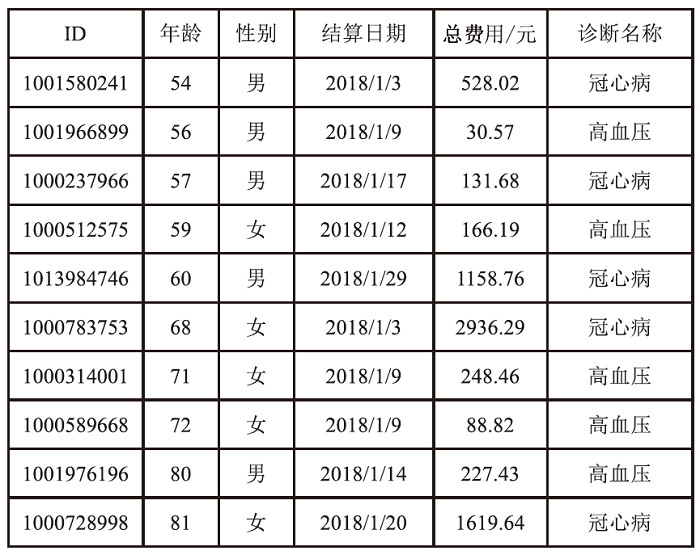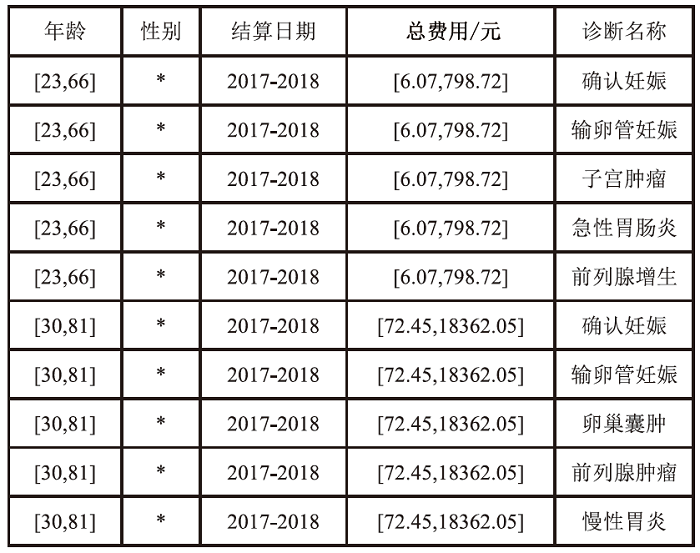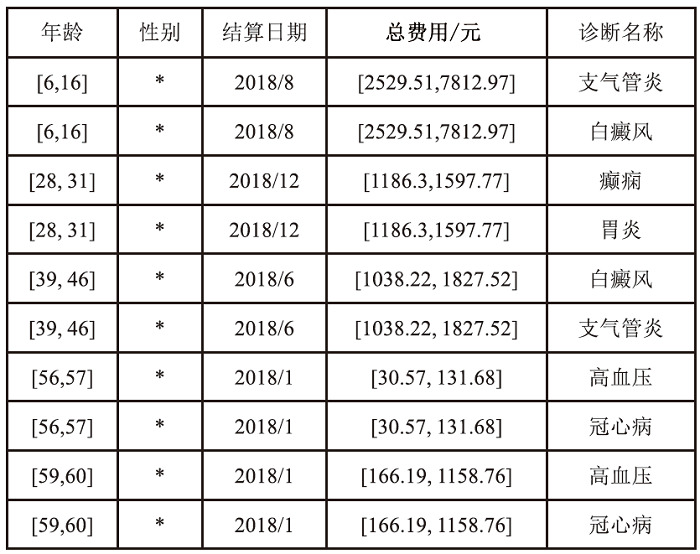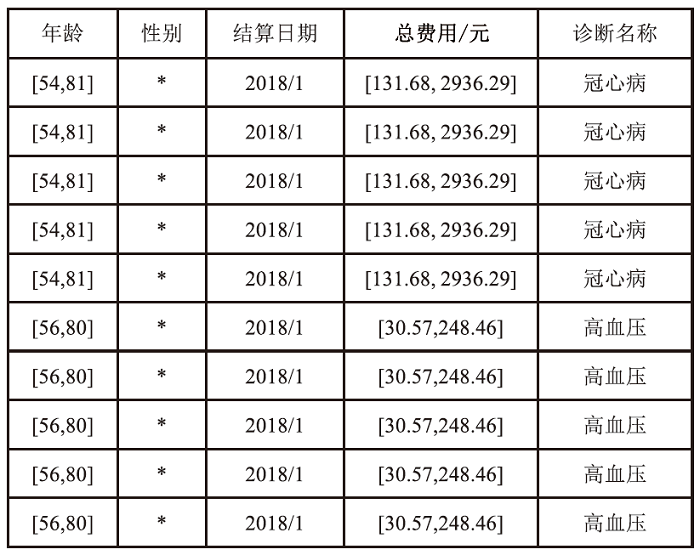Netinfo Security ›› 2024, Vol. 24 ›› Issue (12): 1855-1870.doi: 10.3969/j.issn.1671-1122.2024.12.005
Previous Articles Next Articles
Anonymization General Process and Risk Assessment Method for Data Compliance
YUAN Yulin1,2,3, YUAN Shuguang1,3, YU Jing1,2,3, CHEN Chi1,2,3( )
)
- 1. Institute of Information Engineering, Chinese Academy of Sciences, Beijing 100085, China
2. School of Cyber Security, University of Chinese Academy of Sciences, Beijing 100049, China
3. Key Laboratory of Cyberspace Security Defense, Beijing 100085, China
-
Received:2024-08-20Online:2024-12-10Published:2025-01-10
CLC Number:
Cite this article
YUAN Yulin, YUAN Shuguang, YU Jing, CHEN Chi. Anonymization General Process and Risk Assessment Method for Data Compliance[J]. Netinfo Security, 2024, 24(12): 1855-1870.
share this article
Add to citation manager EndNote|Ris|BibTeX
URL: http://netinfo-security.org/EN/10.3969/j.issn.1671-1122.2024.12.005
| [1] | Ernst & Young Global Limited, Cyber Research Institute. 2021 Global Data Compliance and Privacy Technology Development Report[EB/OL]. [2024-08-05]. https://www.sicsi.org.cn/Upload/ueditor_file/ueditor/20211231/1640943375438233.pdf. |
| 永安(中国)企业咨询有限公司, 赛博研究院. 2021全球数据合规与隐私科技发展报告[EB/OL]. [2024-08-05]. https://www.sicsi.org.cn/Upload/ueditor_file/ueditor/20211231/1640943375438233.pdf. | |
| [2] | Qi An Xin Technology Group Inc. Chinese Government and Enterprise Data Security Risk Analysis Report[EB/OL]. [2024-08-05]. https://www.qianxin.com/threat/reportdetail?report_id=168. |
| 奇安信. 中国政企机构数据安全风险分析报告[EB/OL]. [2024-08-05]. https://www.qianxin.com/threat/reportdetail?report_id=168. | |
| [3] | GB/T 35273-2020 Information Security Technology-Personal Information Security Specification[S]. Beijing: Standards Press of China, 2020. |
| GB/T 35273-2020 信息安全技术个人信息安全规范[S]. 北京: 中国标准出版社, 2020. | |
| [4] | SION L, VAN LANDUYT D, WUYTS K, et al. Privacy Risk Assessment for Data Subject-Aware Threat Modeling[C]// IEEE. 2019 IEEE Security and Privacy Workshops (SPW). New York: IEEE, 2019: 64-71. |
| [5] | National Standardization Administration of the People’s Republic of China. Information Security Technology-Risk Assessment Approaches for Data Security (Draft for Comments)[EB/OL]. (2023-08-20)[2024-08-05]. https://www.tc260.org.cn/file/2023-08-22/9702c85b-9c43-48f4-ac36-23021652f7be.pdf. |
| 国家标准化管理委员会. 信息安全技术数据安全风险评估方法(征求意见稿)[EB/OL]. (2023-08-20)[2024-08-05]. https://www.tc260.org.cn/file/2023-08-22/9702c85b-9c43-48f4-ac36-23021652f7be.pdf. | |
| [6] | ALVIM M S, FERNANDES N, MCIVER A, et al. Flexible and Scalable Privacy Assessment for very Large Datasets, with an Application to Official Governmental Microdata[J]. Proceedings on Privacy Enhancing Technologies, 2022, 2022(4): 378-399. |
| [7] | FUNG B C M, WANG Ke, CHEN Rui, et al. Privacy-Preserving Data Publishing[J]. ACM Computing Surveys, 2010, 42(4): 1-53. |
| [8] | EL E K. Guide to the De-Identification of Personal Health Information[M]. New York: CRC Press, 2013. |
| [9] |
PRASSER F, KOHLMAYER F, KUHN K A. The Importance of Context: Risk-Based De-Identification of Biomedical Data[J]. Methods of Information in Medicine, 2016, 55(4): 347-355.
doi: 10.3414/ME16-01-0012 pmid: 27322502 |
| [10] | ABDELHAMEED S A, MOUSSA S M, KHALIFA M E. Privacy-Preserving Tabular Data Publishing: A Comprehensive Evaluation from Web to Cloud[J]. Computers & Security, 2018, 72: 74-95. |
| [11] | ZIGOMITROS A, CASINO F, SOLANAS A, et al. A Survey on Privacy Properties for Data Publishing of Relational Data[J]. IEEE Access, 1071, 8: 51071-51099. |
| [12] | BANDARA P L M K, BANDARA H D, FERNANDO S. Evaluation of Re-Identification Risks in Data Anonymization Techniques Based on Population Uniqueness[C]// IEEE. 2020 5th International Conference on Information Technology Research (ICITR). New York: IEEE, 2020: 1-5. |
| [13] | DANKAR F K, EL E K, NEISA A, et al. Estimating the Re-Identification Risk of Clinical Data Sets[J]. BMC Medical Informatics and Decision Making, 2012, 12(1): 1-15. |
| [14] | BETHLEHEM J G, KELLER W J, PANNEKOEK J. Disclosure Control of Microdata[J]. Journal of the American Statistical Association, 1990, 85(409): 38-45. |
| [15] | ZAYATZ L V. Estimation of the Percent of Unique Population Elements on a Microdata File Using the Sample[EB/OL]. (1991-08-14)[2024-08-05]. https://permanent.access.gpo.gov/lps40408/lps40408/www.census.gov/srd/papers/pdf/rr91-08.pdf. |
| [16] | ZAYATZ L V. Estimation of the Number of Unique Population Elements Using a Sample[EB/OL]. [2024-01-08]. http://www.asasrms.org/Proceedings/papers/1991_061.pdf. |
| [17] | DIAZ C. Anonymity Metrics Revisited[EB/OL]. [2024-08-05]. https://drops.dagstuhl.de/storage/16dagstuhl-seminar-proceedings/dsp-vol05411/DagSemProc.05411.2/DagSemProc.05411.2.pdf. |
| [18] | BEZZI M, VIMERCATI SDCD, FORESTI S, et al. Modeling and Preventing Inferences from Sensitive Value Distributions in Data Release1[J]. Journal of Computer Security, 2012, 20(4): 393-436. |
| [19] | DIAZ M, WANG Hao, CALMON F P, et al. On the Robustness of Information-Theoretic Privacy Measures and Mechanisms[J]. IEEE Transactions on Information Theory, 2020, 66(4): 1949-1978. |
| [20] | AGRAWAL D, AGGARWAL C C. On the Design and Quantification of Privacy Preserving Data Mining Algorithms[C]// ACM. Proceedings of the Twentieth ACM SIGMOD-SIGACT-SIGART Symposium on Principles of Database Systems. New York: ACM, 2001: 247-255. |
| [21] | WAGNER I, ECKHOFF D. Technical Privacy Metrics[J]. ACM Computing Surveys, 2019, 51(3): 1-38. |
| [22] | DU P C F, FAWAZ N. Privacy against Statistical Inference[C]// IEEE. 2012 50th Annual Allerton Conference on Communication, Control, and Computing (Allerton). New York: IEEE, 2012: 1401-1408. |
| [23] | ANTONATOS S, BRAGHIN S, HOLOHAN N, et al. PRIMA: An End-to-End Framework for Privacy at Scale[C]// IEEE. 2018 IEEE 34th International Conference on Data Engineering (ICDE). New York: IEEE, 2018: 1531-1542. |
| [24] | OMAR Elgabry. The Ultimate Guide to Data Cleaning[EB/OL]. (2019-01-03)[2024-01-08]. https://towardsdatascience.com/the-ultimate-guide-to-data-cleaning-3969843991d4. |
| [25] | CHEN Shudong, OUYANG Xiaoye. Overview of Named Entity Recognition Technology[J]. Radio Communications Technology, 2020, 46(3): 251-260. |
| 陈曙东, 欧阳小叶. 命名实体识别技术综述[J]. 无线电通信技术, 2020, 46(3): 251-260. | |
| [26] | GB/T 37964-2019 Information Security Technology-Guide for De-Identifying Personal Information[S]. Beijing: Standards Press of China, 2019. |
| GB/T 37964-2019 信息安全技术个人信息去标识化指南[S]. 北京: 中国标准出版社, 2019. | |
| [27] | YAN Weiwei, XIE Shunxin, PAN Jing, et al. Data Classification: Research Progress, Policy Standards and Enterprise Practice[J]. Digital Library Forum, 2022(9): 2-12. |
| 严炜炜, 谢顺欣, 潘静, 等. 数据分类分级:研究趋势、政策标准与实践进展[J]. 数字图书馆论坛, 2022(9): 2-12. | |
| [28] | LEFEVRE K, DEWITT D J, RAMAKRISHNAN R. Mondrian Multidimensional K-Anonymity[C]// IEEE. 22nd International Conference on Data Engineering (ICDE’06). New York: IEEE, 2006: 25-35. |
| [29] |
EL E K, DANKAR F K, ISSA R, et al. A Globally Optimal K-Anonymity Method for the De-Identification of Health Data[J]. Journal of the American Medical Informatics Association, 2009, 16(5): 670-682.
doi: 10.1197/jamia.M3144 pmid: 19567795 |
| [30] | KOHLMAYER F, PRASSER F, ECKERT C, et al. Flash:Efficient, Stable and Optimal K-Anonymity[C]// IEEE. 2012 International Conference on Privacy, Security, Risk and Trust and 2012 International Confernece on Social Computing. New York: IEEE, 2012: 708-717. |
| [31] | XU Jian, WANG Wei, PEI Jian, et al. Utility-Based Anonymization Using Local Recoding[C]// ACM. Proceedings of the 12th ACM SIGKDD International Conference on Knowledge Discovery and Data Mining. New York: ACM, 2006: 785-790. |
| [32] | BAYARDO R J, AGRAWAL R. Data Privacy through Optimal K-Anonymization[C]// IEEE. 21st International Conference on Data Engineering (ICDE’05). New York: IEEE, 2005: 217-228. |
| [33] | IYENGAR V S. Transforming Data to Satisfy Privacy Constraints[C]// ACM. Proceedings of the Eighth ACM SIGKDD International Conference on Knowledge Discovery and Data Mining. New York: ACM, 2002: 279-288. |
| [34] | LUO Kang. Design and Implementation of Privacy Risk Assessment System for Medical Data Release[D]. Guiyang: Guizhou University, 2022. |
| 罗康. 医疗数据发布的隐私泄露风险评估系统设计与实现[D]. 贵阳: 贵州大学, 2022. | |
| [35] | WU Ruixue. Research on Rational Privacy Protection Model and Algorithm Based on Association Rules[D]. Guiyang: Guizhou University, 2019. |
| 吴睿雪. 基于关联规则的理性隐私保护模型及算法研究[D]. 贵阳: 贵州大学, 2019. | |
| [36] | MACHANAVAJJHALA A, GEHRKE J, KIFER D, et al. L-Diversity: Privacy Beyond K-Anonymity[C]// IEEE. 22nd International Conference on Data Engineering (ICDE’06). New York: IEEE, 2006: 24-28. |
| [37] | LI Ninghui, LI Tiancheng, VENKATASUBRAMANIAN S. T-Closeness: Privacy beyond K-Anonymity and L-Diversity[C]// IEEE. 2007 IEEE 23rd International Conference on Data Engineering. New York: IEEE, 2007: 106-115. |
| [38] | National Standardization Administration of the People’s Republic of China. Information Security Technology-Requirements for Classification and Grading of Network Data (Draft for Comments)[EB/OL]. (2022-09-14)[2024-08-05]. https://www.tc260.org.cn/file/2022-09-14/edb6ff74-01f8-4b40-8979-e2f9a34eba36.pdf. |
| 国家标准化管理委员会. 信息安全技术网络数据分类分级要求(征求意见稿)[EB/OL]. (2022-09-14)[2024-08-05]. https://www.tc260.org.cn/file/2022-09-14/edb6ff74-01f8-4b40-8979-e2f9a34eba36.pdf. | |
| [39] | National Standardization Administration of the People’s Republic of China. Information Security Technology-Security Requirements for Processing of Sensitive Personal Information (Draft for Comments)[EB/OL]. (2023-08-08)[2024-08-05]. https://www.tc260.org.cn/file/2023-08-08/cf1db508-85e0-4ac0-abc6-ee619e004a25.pdf. |
| 国家标准化管理委员会. 信息安全技术敏感个人信息处理安全要求 (征求意见稿)[EB/OL]. (2023-08-08)[2024-08-05]. https://www.tc260.org.cn/file/2023-08-08/cf1db508-85e0-4ac0-abc6-ee619e004a25.pdf. | |
| [40] | National Standardization Administration of the People's Republic of China. Information Security Technology-Guide for Evaluating the Effectiveness of Personal Information De-Identification[EB/OL]. (2023-03-17)[2024-08-05]. http://c.gb688.cn/bzgk/gb/showGb?type=online&hcno=E1A4E7943D64346D9EF1E3D0855F8496. |
| 国家标准化管理委员会. 信息安全技术个人信息去标识化效果评估指南[EB/OL]. (2023-03-17)[2024-08-05]. http://c.gb688.cn/bzgk/gb/showGb?type=online&hcno=E1A4E7943D64346D9EF1E3D0855F8496. | |
| [41] | GB/T 39725-2020 Information Security Technology-Guide for Health Data Security[S]. Beijing: Standards Press of China, 2020. |
| GB/T 39725-2020 信息安全技术健康医疗数据安全指南[S]. 北京: 中国标准出版社, 2020. | |
| [42] | CHEN Guang, KELLER-MCNULTY S. Estimation of Identification Disclosure Risk in Microdata[J]. Journal of Official Statistics, 1998, 14(1): 79-85. |
| [43] | RAO S S. Engineering Optimization Theory and Practice[M]. Hoboken: Wiley, 2019. |
| [44] | CUI Binkai. Analysis on Ecological Sensitivity and Resilience of Pingliang City Based on Entropy Method and AHP[D]. Lanzhou: Lanzhou University, 2023. |
| 崔斌凯. 基于熵值法和层次分析法的平凉市生态敏感性与恢复力分析[D]. 兰州: 兰州大学, 2023. | |
| [45] | ZHAO Jun, REN Yi, LI Bao, et al. Research on the Supply Chain Security Risk Assessment Methods for Mixed Source Operating System[J]. Netinfo Security, 2023, 23(5): 50-61. |
| 赵俊, 任怡, 李宝, 等. 混源操作系统供应链安全风险评估方法研究[J]. 信息网络安全, 2023, 23(5): 50-61. | |
| [46] | LIN Li. Research on Collaborative Filtering Recommendation Algorithm of Books Based on Analytic Hierarchy Process[J]. Software Guide, 2023, 22(10): 178-184. |
| 林丽. 基于层次分析法的图书协同过滤推荐算法研究[J]. 软件导刊, 2023, 22(10): 178-184. | |
| [47] | SAATY T L. A Scaling Method for Priorities in Hierarchical Structures[J]. Journal of Mathematical Psychology, 1977, 15(3): 234-281. |
| [48] | KELE_87. Medical Data[EB/OL]. [2024-08-05]. https://www.heywhale.com/mw/dataset/5fe48c919762b2003013847a. |
| KELE_87. 医疗数据[EB/OL]. [2024-08-05]. https://www.heywhale.com/mw/dataset/5fe48c919762b2003013847a. |
| [1] | SUN Yu, XIONG Gaojian, LIU Xiao, LI Yan. A Survey on Trusted Execution Environment Based Secure Inference [J]. Netinfo Security, 2024, 24(12): 1799-1818. |
| [2] | JIN Zhigang, CHEN Xuyang, WU Xiaodong, LIU Kai. A Review of Incremental Intrusion Detection [J]. Netinfo Security, 2024, 24(12): 1819-1830. |
| [3] | HE Zeping, XU Jian, DAI Hua, YANG Geng. A Review of Federated Learning Application Technologies [J]. Netinfo Security, 2024, 24(12): 1831-1844. |
| [4] | CUI Ting, ZHOU Yidong, CHEN Shiwei, ZHANG Yi. The Spectral Invariant Subspace of Word-Based Block Ciphers [J]. Netinfo Security, 2024, 24(12): 1845-1854. |
| [5] | LI Kehui, CHEN Jie, LIU Jun. A White-Box Improvement Scheme of SM4 for Collision Attack [J]. Netinfo Security, 2024, 24(12): 1871-1881. |
| [6] | ZHANG Guomin, TU Zhixin, XING Changyou, WANG Zipeng, ZHANG Junfeng. Traffic Obfuscation Method for Temporal Features Based on Adversarial Example [J]. Netinfo Security, 2024, 24(12): 1882-1895. |
| [7] | LI Yixuan, JIA Peng, FAN Ximing, CHEN Chen. Control Flow Transformation Based Adversarial Example Generation for Attacking Malware Detection GNN Model [J]. Netinfo Security, 2024, 24(12): 1896-1910. |
| [8] | XU Jianfeng, ZHANG Wei, TU Min, WEI Qingting, LAI Zhanqing, WANG Qianqian. A k-Anonymity Completion Method Generated Based on Semantic Fusion Trajectories [J]. Netinfo Security, 2024, 24(12): 1911-1921. |
| [9] | LIU Zhuoxian, WANG Jingya, SHI Tuo. Research on Malicious URL Detection Using a Multi-Channel Neural Network that Integrates Adversarial Training with BERT-CNN-BiLSTM [J]. Netinfo Security, 2024, 24(12): 1922-1932. |
| [10] | ZHANG Xuan, WAN Liang, LUO Heng, YANG Yang. Automated Botnet Detection Method Based on Two-Stage Graph Learning [J]. Netinfo Security, 2024, 24(12): 1933-1947. |
| [11] | DIAO Yigang. Analysis for Hotspots and Trends in the Field of Personal Information Protection Based on CiteSpace Tools [J]. Netinfo Security, 2024, 24(12): 1948-1954. |
| [12] | LI Wanqing, ZHU Li, LIU Xing’an, ZHENG Wei, GU Yishun. Cybersecurity Protection Technologies for Critical Information Infrastructure in Hydropower Plants [J]. Netinfo Security, 2024, 24(12): 1955-1962. |
| [13] | YIN Jie, CHEN Pu, YANG Guinian, XIE Wenwei, LIANG Guangjun. Detection of DDoS Attacks in the Internet of Things Based on Artificial Intelligence [J]. Netinfo Security, 2024, 24(11): 1615-1623. |
| [14] | LI Pengchao, ZHANG Quantao, HU Yuan. Smart Contract Vulnerability Detection Method Based on Graph Convolutional Network with Dual Attention Mechanism [J]. Netinfo Security, 2024, 24(11): 1624-1631. |
| [15] | CHEN Baogang, ZHANG Yi, YAN Song. Research on Multi-Factor Continuous Trustworthy Identity Authentication for Users in Civil Aviation Air Traffic Control Operational Information Systems [J]. Netinfo Security, 2024, 24(11): 1632-1642. |
| Viewed | ||||||
|
Full text |
|
|||||
|
Abstract |
|
|||||








